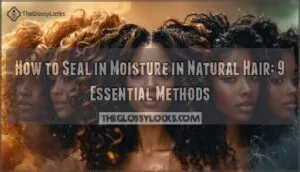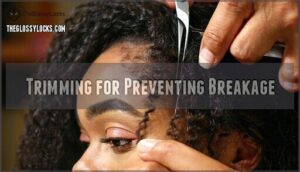This site is supported by our readers. We may earn a commission, at no cost to you, if you purchase through links.
 Your wash day routine might be impeccable, but if you’re not sealing in that moisture properly, you’re watching hours of work evaporate—literally. Natural hair loses hydration faster than most people realize, especially when porosity levels, environmental factors, and daily manipulation work against you.
Your wash day routine might be impeccable, but if you’re not sealing in that moisture properly, you’re watching hours of work evaporate—literally. Natural hair loses hydration faster than most people realize, especially when porosity levels, environmental factors, and daily manipulation work against you.
The difference between hair that stays soft for days versus frizzing out by noon often comes down to one thing: how well you lock moisture into each strand. Mastering moisture retention isn’t about piling on more products—it’s about using the right techniques in the right order, protecting your hair from moisture thieves like heat and friction, and understanding what your specific texture actually needs.
These nine methods will help you keep your curls hydrated, elastic, and strong between wash days.
Table Of Contents
- Key Takeaways
- Why is Hydration Important?
- How to Lock in Moisture: The LOC Method
- Minimizing Heat Exposure
- Avoid Excessive Touching
- Sleeping in a Satin Bonnet
- Protective Hairstyles for Moisture Retention
- The Importance of Deep Conditioning
- Regularly Spritzing Leave-in Conditioner
- Trimming for Preventing Breakage
- Tips for Easier Hair Care
- Frequently Asked Questions (FAQs)
- What is sealing in moisture?
- How do you seal moisture into your hair?
- Should you seal your hair?
- How do I keep moisture in my hair without oil?
- How do you keep hair strands moist?
- How do I hydrate my hair before sealing?
- What are the best products for 4C hair?
- Is the LOC method suitable for all hair types?
- How often should I trim my hair?
- Is it necessary to wear a satin bonnet every night?
- Conclusion
Key Takeaways
- Moisture retention depends on sealing hydration into your strands using the LOC method (liquid, oil, cream) rather than constantly reapplying products, with your hair’s porosity level determining which products work best.
- Protecting moisture requires minimizing friction and heat exposure through satin bonnets, protective hairstyles, and reduced manipulation, since cotton fabrics and constant touching strip away the sealed moisture barrier.
- Deep conditioning weekly boosts moisture retention by up to 35% and reduces breakage by 30-40%, making it the foundation of any hydration strategy rather than an optional luxury.
- Regular trims every 8-12 weeks prevent split ends from traveling up the hair shaft like leaky faucets, ensuring your sealing efforts actually work instead of fighting damaged ends that can’t hold moisture.
Why is Hydration Important?
Hydration is the backbone of healthy natural hair—without it, your strands become brittle, dull, and prone to breakage. When you keep your hair properly moisturized, you’re improving its elasticity and strength, which means less damage and better length retention.
Understanding hair biology helps: your hair’s porosity determines how well it absorbs and holds moisture, so you’ll need to match your hydration routine to your specific hair type. Hair moisture isn’t just about what you apply externally—water intake matters too, since your body needs proper hydration to foster hair growth from within.
The moisture balance you create through hydrating deep conditioners and moisture sealing techniques protects your strands and keeps them flexible. These hydration benefits show up as softer, shinier curls that resist breakage and hold styles better throughout the day. Drinking enough water fosters overall hair health benefits and is essential for maintaining healthy hair.
How to Lock in Moisture: The LOC Method
Once you’ve got moisture in your hair, the real trick is keeping it there—and that’s where the LOC method comes in. This product layering technique gives you control over moisture retention by stacking your products strategically. The name tells you exactly what to do:
- Liquid – Start with water or a leave-in conditioner to hydrate your strands based on your hair porosity
- Oil – Apply your chosen oil to create a barrier that traps the liquid inside
- Cream – Finish with a butter or cream to reinforce the seal and smooth everything down
Your sealant choices matter—lighter oils work for fine hair, while thicker butters suit coarse textures.
This moisture sealing approach keeps your curls soft for days, not hours, giving you the hydration techniques that actually stick around.
Minimizing Heat Exposure
Heat is one of the fastest ways to undo all the moisture work you’ve just put in, so protecting your strands from high temperatures isn’t optional—it’s survival. When you do reach for hot tools, always apply a thermal protectant to damp hair first—this creates a shield that reduces damage and helps with moisture retention. Choose low heat settings instead of cranking up the temperature, and consider heat styling alternatives like air drying methods or gentle blowouts on cool settings.
Your hair porosity matters here—high porosity natural hair loses moisture faster under heat, making protective styles a smarter choice between styling sessions.
| Method | Temperature | Protection Level |
|---|---|---|
| Air Drying | None | Maximum moisture retention |
| Cool Blowout | Low (under 300°F) | High with protectant |
| Flat Iron | Medium (300-350°F) | Moderate with protectant |
Avoid Excessive Touching
Your hands can be your hair’s worst enemy—every time you twist, pull, or run your fingers through your curls, you’re actually disrupting the moisture seal you worked so hard to create. Touch damage leads to frizz control problems and hair breakage, turning those healthy ends into dry, frayed ends fast. Your hand habits matter more than you think—constant manipulation lifts the cuticle layer, letting precious moisture escape and leaving your strands vulnerable.
Here’s how to practice gentle management for better hair moisture retention:
- Keep styling sessions intentional rather than mindless—touch your hair only when moisturizing or detangling
- Lock your curls into protective styles on busy days to minimize unnecessary contact
- Fight the urge to "fluff" or separate curls throughout the day, which destroys your clumping pattern
- Apply products with purposeful, downward smoothing motions instead of roughing them through
Sealing your hair means nothing if you’re constantly undoing that work with your hands. Moisture retention depends on leaving those sealed cuticles alone.
Sleeping in a Satin Bonnet
Cotton pillowcases steal moisture from your hair while you sleep, but wrapping your curls in a satin bonnet creates a protective barrier that keeps every drop of hydration locked in until morning. Satin bonnets—or their silk pillowcase alternatives—reduce friction that causes frizz and breakage, protecting your nighttime hair care investment. You’ll notice smoother, more defined curls when you wake up because the fabric doesn’t absorb your leave-in products or natural oils like cotton does.
| Nighttime Hair Care | Moisture Retention Benefits |
|---|---|
| Satin silk bonnet | Prevents moisture loss through friction |
| Silk pillowcase | Gentler alternative for bonnet-averse sleepers |
| Protective styles underneath | Maximizes morning hair routine efficiency |
| Pre-bed moisture spritz | Amplifies satin bonnet benefits overnight |
Your morning hair routine becomes seamless when you prioritize hair frizz prevention at night—no more waking up to dried-out, tangled hair.
Protective Hairstyles for Moisture Retention
Protective hairstyles act like armor for your strands, tucking away your ends and locking in moisture while you go about your life without constant manipulation. Braided styles like cornrows, twist outs, and Bantu knots create a moisture-locking seal that works with your hair porosity instead of against it. Low manipulation means less friction, less breakage, and more time for your natural hair to absorb the hydration you’ve worked so hard to seal in.
Consider these protective hairstyles for maximum moisture retention:
- Box braids with sealed ends – Hair wrapping techniques keep moisture locked in for weeks
- Two-strand twists – Gentle on delicate strands while maintaining definition
- Flat twists or cornrows – Close to the scalp styles that minimize environmental exposure
- Low buns and updos – Elegant options that protect ends from rubbing against clothing
Your weaving and styling choices directly impact how well your hair holds onto moisture between wash days.
The Importance of Deep Conditioning
Deep conditioning isn’t just a luxury—it’s the foundation of serious moisture retention for natural hair. When you deep condition weekly, you’re boosting moisture retention by up to 35% and slashing breakage rates by 30–40%. This treatment works with your hair porosity, helping high-porosity strands seal their raised cuticles while giving low-porosity hair the penetration it desperately needs.
Adding heat during deep conditioning improves product absorption by 25%, transforming your hair elasticity and scalp health. Regular deep conditioning can also enhance natural shine by smoothing the hair cuticle.
The result? Hair that stays moisturized longer, detangles 35% faster, and retains length like never before. Your hair hydration strategy starts here.
Regularly Spritzing Leave-in Conditioner
Think of leave-in conditioner as your hair’s hydration lifeline between wash days—a quick spritz can mean the difference between brittle strands and bouncy, moisturized curls. Daily spritzing helps maintain moisture balance, especially for high-porosity hair that loses hydration fast.
You can create your own DIY spritz by mixing water with your favorite leave-in conditioner, or grab a ready-made option like a bamboo and coconut milk formula. Start with a light mist—you’re reviving, not soaking. Focus on your mid-lengths and ends where dryness hits hardest.
Here’s the key: spritzing works best when you follow up with sealing moisture using a light oil or cream. That’s your one-two punch for keeping 4C curls hydrated all day. Just don’t overdo it—too much product buildup can actually rob your hair of moisture over time.
Keep your leave-in products handy for quick touch-ups throughout the week. Your curls will stay soft, manageable, and ready for whatever comes next.
Trimming for Preventing Breakage
Split ends are like leaky faucets—they drain moisture faster than your hair can absorb it, making every hydration effort feel like a losing battle. Trimming hair every 8-12 weeks is your damage control strategy, cutting off frayed ends before they split further up the strand and cause hair breakage. Even protective styles won’t save you if your hair ends are already compromised. Regular hair trimming isn’t about losing length—it’s about keeping what you’ve grown healthy enough to retain. Split end repair starts with prevention, not products.
Why trimming wins the breakage prevention battle:
- Damaged ends can’t hold moisture, no matter how many oils you layer on
- One split can travel up your strand like a zipper, destroying months of growth
- Healthy ends mean your sealing routine actually works instead of fighting dry frayed ends
Tips for Easier Hair Care
Your hair care routine doesn’t have to be complicated—once you’ve built the right habits, maintaining moisture becomes second nature instead of a daily struggle. Start with hair product selection that matches your porosity—lighter oils for low porosity, heavier butters for high. Your daily moisture routine should follow moisturizing and sealing principles: water first, then oil to lock it in. Gentle combing techniques prevent breakage that undermines your sealing efforts. Try scalp massage benefits—stimulating blood flow while distributing oils keeps your hair moisturized from root to tip. Hair growth supplements support hydration from within, but external moisture sealing remains your foundation for hair care success.
Quick wins for keeping your hair moisturized:
- Master the LOC method once—it becomes automatic after a week
- Keep a spray bottle handy for mid-week moisture boosts between wash days
- Invest in satin bonnets and pillowcases to stop losing hydration overnight
- Touch your hair less during the day to preserve your sealing layer
- Schedule trims every 8-12 weeks so sealing your hair actually works
Frequently Asked Questions (FAQs)
What is sealing in moisture?
Sealing moisture is like locking the door after you’ve filled your home with warmth—it traps hydration inside your hair strands using natural oils or butters. This sealing technique creates a protective barrier that prevents water from escaping, maintaining your hair’s moisture balance and keeping those ends soft instead of frayed.
How do you seal moisture into your hair?
Start by applying a water-based leave-in conditioner to damp hair—moisture levels depend on your hair porosity and texture.
Follow with the LOC method: layer oil to seal, then cream for extra protection. This product layering technique locks hydration in effectively.
Should you seal your hair?
Like a leaky bucket that can’t hold water, unsealed hair struggles to maintain hydration no matter how much moisture you add. Yes, you should seal your hair—it’s essential for moisture retention and preventing breakage in natural hair care.
Understanding hair porosity types helps you choose the right sealing techniques for best results.
How do I keep moisture in my hair without oil?
If you’d prefer skipping oils, focus on water-based leave-in products and creams to maintain moisture balance.
Deep condition weekly, use humidity control techniques, and protect your hair at night—these sealing hair techniques work without relying on traditional oils while supporting moisture retention.
How do you keep hair strands moist?
As the saying goes, "An ounce of prevention is worth a pound of cure." Keep hair strands moist by understanding your hair porosity, then applying daily hydration through water-based products, natural oils, and proper sealing techniques that lock in moisture balance while maintaining your hair moisturized throughout the week.
How do I hydrate my hair before sealing?
Hydrating Masks and water-based products are your pre-sealing essentials. Apply a moisturizing leave-in or hydrating spray first—moisture retention starts with proper hair hydration.
This moisture prep ensures you’re locking in something worth keeping.
What are the best products for 4C hair?
Think of 4C hair as a garden that thrives when you choose the right nourishment.
For your natural hair, reach for cream moisturizers like Taliah Waajid Curly Curl Cream, then seal with natural butters or hair oils using the LOC method.
Don’t forget leave-in products and hair serums to keep your hair moisturized between washes.
Is the LOC method suitable for all hair types?
The LOC method works best for high porosity natural hair that loses moisture quickly.
Your hair texture and porosity levels determine whether product layering helps or weighs you down—fine hair types may need lighter alternatives for effective moisture retention.
How often should I trim my hair?
Trimming every 6-8 weeks keeps split ends at bay and maintains your hair health routine. Regular trim schedules help with damage control, breakage patterns, and healthier hair growth.
You’ll notice fuller, more manageable curls that actually cooperate when you style them.
Is it necessary to wear a satin bonnet every night?
Skipping your satin bonnet is practically asking for a hair disaster. While you don’t need to wear one every single night, it’s your best defense against cotton pillowcases that steal moisture and cause friction.
You’ll keep your natural hair hydrated, reduce breakage, and wake up with healthier curls when you make nighttime hair care a habit.
Conclusion
Think of your natural hair like a garden after rain—water alone won’t keep it thriving if the soil can’t hold it. Sealing in moisture in natural hair requires the right systems: layering products strategically, shielding strands from friction and heat, and maintaining a routine that respects your hair’s unique porosity.
When you treat hydration as something to protect rather than constantly replace, you give your curls the foundation they need to stay soft, defined, and resilient. Your hair isn’t high-maintenance—it just needs the right maintenance.
- https://www.tothecurlmarket.com/how-to-fix-dry-natural-hair/
- https://finenaturalhairandfaith.com/wet-natural-hair-every-day/
- https://www.reddit.com/r/HaircareScience/comments/78ppm4/moisturizing_and_sealing_loc_method_and_its/
- https://www.mycurlproducts.com/blogs/healthy-natural-haircare/the-strength-of-oil-and-shea-butter-how-they-seal-in-moisture-for-natural-hair
- https://www.styledomination.com/beauty/moisturizing-and-sealing-the-secret-to-fix-dry-damaged-hair/











